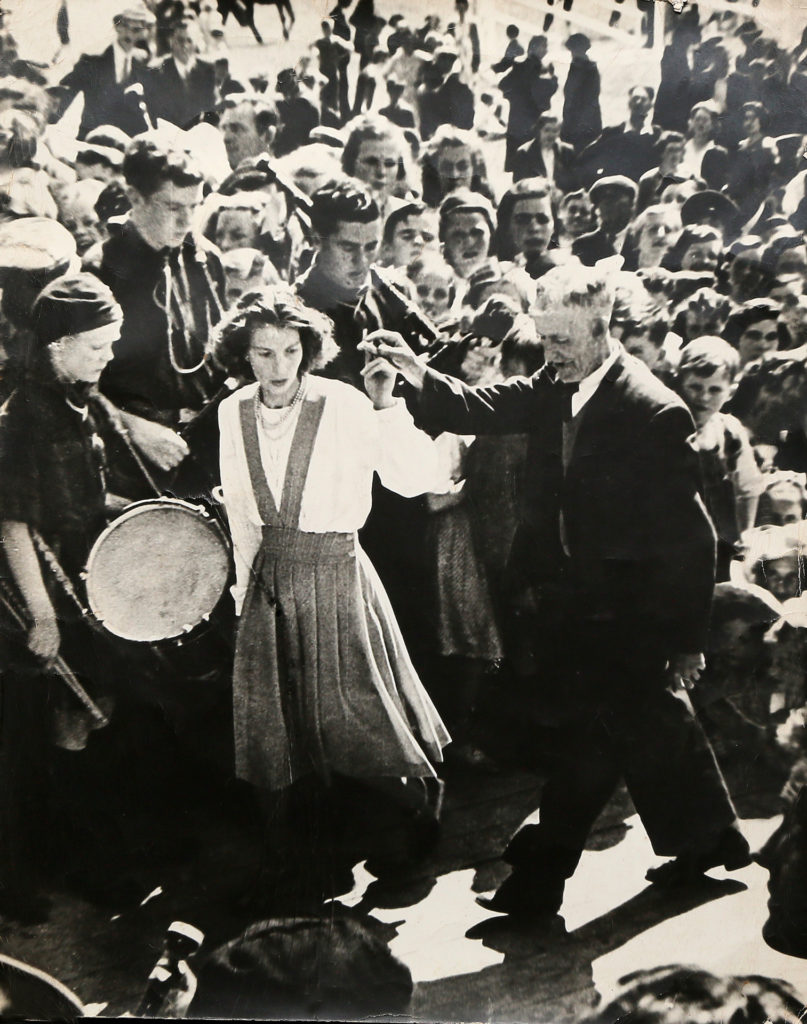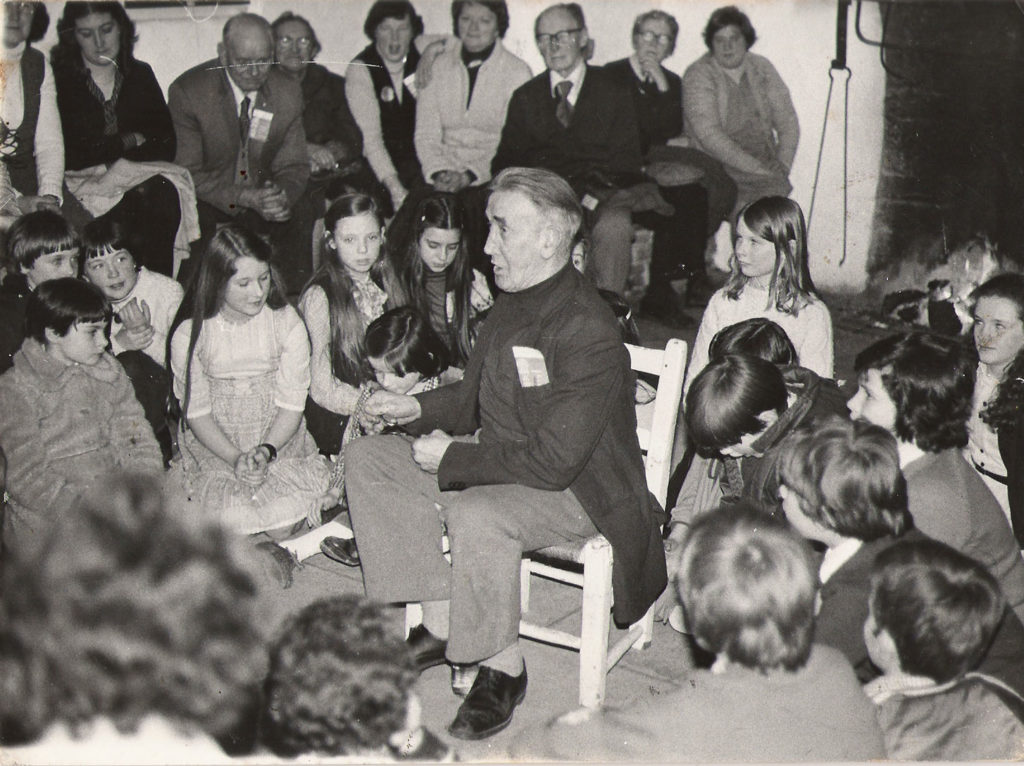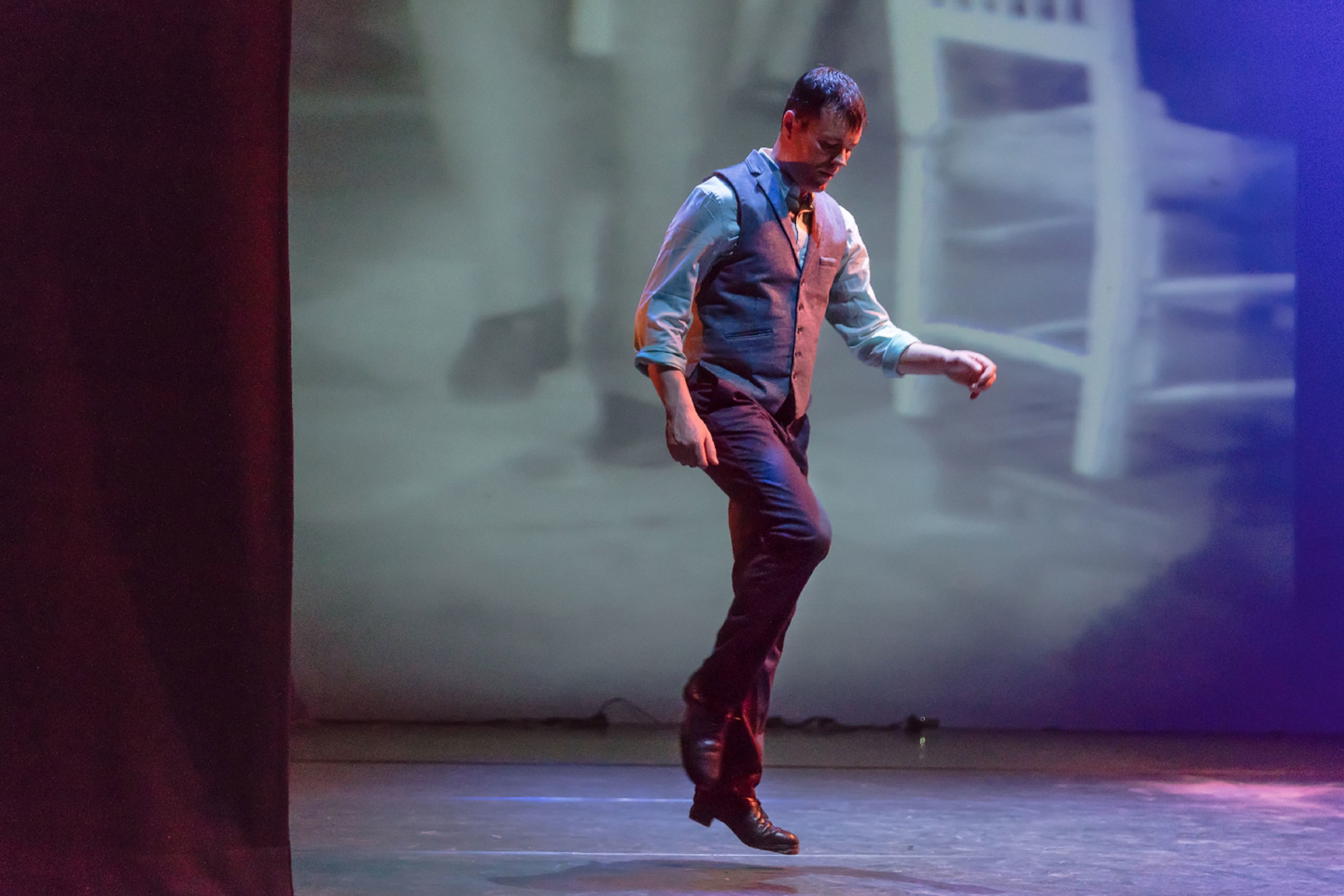They danced without music; instead the percussion of their shoes marked the rhythm.
Jimmy Hickey’s slender feet lightly tapped the cold stone of the cottage floor, his knees bent with spritely steps that belied his 80 years. Jonathan Kelliher danced in unison at his side, twisting his ankles, clacking his heels and memorizing sequences to a dance that was once banned from Ireland’s dance halls and competitions.
This is Munnix, a percussive style from County Kerry, and is down-to-the-ground and spacious in rhythm — a contrast from the flying batters, rapid-fire steps and ramrod-straight postures that are usually associated with modern Irish dance.
“You’re telling a story with your dancing, you are,” says Hickey, knocking off some quick raps of his toes. “Parts of the dance are slowing down, but the music follows you. The modern dancing today, you don’t know whether they’re playing a jig, a reel or a hornpipe because they stunt the music so much,” he says.
“Nothing against modern dancing,” says Kelliher, 50, a dance master and the artistic director at Siamsa Tíre, the National Folk Theatre of Ireland. “But the older style has space and movement within the beat and rhythm. Just listen to the difference between the two — they’re completely different.”
Munnix dance once thrived in the wild countryside of southwest Ireland, despite a ban by the formal world of Irish dancing. Its snaking ankles and loose arms were considered a threat to modern Irish dance but the defiant dance masters in farming communities kept it alive by traveling from parish to parish and teaching it during long winter nights.
Hickey had inherited intricate moves from the dance masters as a boy in the 1950s and soon began teaching them in local schools. Kelliher learned it from Hickey when he was 6 and joined Siamsa Tíre as an adult to become the next generation’s champion of Munnix.
Despite decades in the classroom, Hickey’s more-difficult Munnix repertoire could easily have been lost. While he had devoted himself to teaching the Irish dances of all forms, he had never passed on his most complicated Munnix steps. However, the pandemic has given this unusual Irish dance an unlikely boost. When schools shut their doors in 2020, Hickey was forced to cancel dance classes for the first time in 68 years as a teacher. Not one to sit idle, once government restrictions relaxed, Hickey started meeting Kelliher at a small, white cottage in the village of Finuge every Thursday to pass on his most complicated, and coveted, steps of this almost-forgotten Irish dance. However, through weekly meetings at the cottage with Kelliher, Hickey remembered elaborate sequences, which turned out to be a silver lining in a difficult time.
Irish dancing was once as varied as Ireland’s accents. Each region had its own interpretation of step dance. Munnix dates back to at least the late 1700s and is named after Jeremiah Molyneaux, a man locally known as Jerry Munnix. Molyneaux lived in the early 20th century but was so inventive in choreography and prolific in teaching that the style got named after him and became popularized during an age when local dances in Ireland were disappearing across the country.

When Molyneaux was a boy, traveling dance masters taught everywhere from kitchens to crossroads, and on anything, including table tops, half doors, barrel tops, even anvils. Many also offered lessons in deportment, fencing, and the martial art of stick fighting. They had regular circuits and stayed with a family for weeks before moving on to the next parish.
But this system was threatened from the very people who wanted to safeguard Irish dance and identity. During the late 1800s, a national movement known as the Gaelic revival swept across Ireland in a push against British occupation. The British had stripped Catholics of their rights, land and culture through laws forbidding land ownership and self-rule. British policy also portrayed Gaelic culture as backward and linked to poverty.
Hence, when the idea of the nation-state, defined by a shared ethnicity, language and culture was spreading across Europe, Irish leaders recognized that pride in Gaelic culture could help lay a foundation for independence. Douglas Hyde, who went on to become the first president of the Republic of Ireland, had warned in 1892, “I wish to show you that in Anglicising ourselves wholesale we have thrown away with a light heart the best claim which we have upon the world’s recognition of us as a separate nationality.”
Cultural leaders sought to define and promote a distinct Irish identity by fostering the Irish language, sports like hurling and Gaelic football, literature and the arts. Hence, dance became an integral part of the Irish identity.
Following the partition of Ireland in 1921, when the northernmost six counties became Northern Ireland and the remaining 26 the Irish Free State, the Gaelic League formed the Irish Dancing Commission to preserve Irish dance by standardizing its instruction and grading. This eventually molded Irish dance into the form globally loved today, with swift footwork and athletic leaps popularized by Riverdance, a touring theatrical show.
However, the well-intended commission also pruned its repertoire from anything considered foreign and regulated dance to such a degree that it extinguished distinctive local dances. The commission considered rural dance masters to be inferior and anyone who taught outside its repertoire was barred from the organization, its competitions and dance halls. This created two systems: the long-established rural approach and a formal urban one.
Not everyone agreed with this method. Long before the foundation of the Irish Dancing Commission, the Irish writer and nationalist Padraig Pearse, a leader of the 1916 Easter Rising, had warned that Irish dances belonged to “cottage fires” and “to transplant them was to kill them.”
In the countryside, dance cemented social connections. At weddings, country dances, and fairs, many a match was made on the dance floor but, as Pearse recognized, dancing at home by the heat of the hearth was equally important to country life.
Traveling dance masters would stay with a host for several weeks. On long winter nights, people of all ages from the surrounding patchwork of tiny fields gathered weekly at the host’s house. The dance master, accompanied by local musicians, taught children the jib, the treble reel and the hornpipe in the sitting room. As the fiddle or melodeon played, adults gathered in the kitchen, engaged in storytelling, performing dance sets and catching up on news about the neighbors, the harvest and the price of livestock. They often danced until dawn, when it was time to go home and milk the cows. Many rural dance styles survived into the 1960s and at fairs, and the region of each dancer could be identified by their movements.
However, slowly and steadily, the variety vanished. But Munnix continued to flourish in the southwest, thanks to determined dance teachers and a countryside culture where few felt obligated to adhere to the top-down regulations from the cities. County Kerry was remote and poor, with a rural population dependent on farming. Well-intended ideals and dance regulations from a distant Dublin felt irrelevant.
Molyneaux, who was at his peak during the standardization of competitive Irish dance, had had little interest in joining the commission. Neither his livelihood nor social standing depended on it, and he enjoyed great respect and status. It was an honor in the community to claim him as a teacher. Additionally, north Kerry dancers practiced an inventive style that required spontaneity and creativity rather than following rigid choreography.
Molyneaux is celebrated as the last of the traveling dance masters. Born in 1883, the youngest of seven, he in 1903 began a teaching career that spanned half a century. He was 4 feet, 11 inches tall and is remembered as dapper, clean-shaven and a lean person “with small, neat feet.” He was known to be better dressed than the gentry, and it was considered an honor to play host to his circuit in north Kerry villages.
After spending six weeks in a village, Molyneaux held a benefit to showcase his students’ skills and then walked or rode to the next parish. Many students were farm workers, so rainy winter nights were good for business. During the summer harvest season, Lent, Advent or periods when the parish priest denied permission to teach dance, Molyneaux turned to other trades, including carpentry and cobbling. He also bred canaries as a hobby. After Munnix died in 1965 at age 83, he was buried with his best pair of dancing shoes.

Today, the Irish Dancing Commission allows competitions to include set dances with regional choreography, like the Priest in His Boots (West Limerick and County Clare) and Molyneaux’s own choreography for The Blackbird. But with national standardization, the local vernacular is easily lost.
“In the Irish dance world what matters is getting the step but not the style,” says Catherine Foley, who taught ethnochoreology and Irish traditional performance at the University of Limerick for more than 20 years. “In one way it is marvelous that Munnix is recognized and that people from the organization are dancing the steps, but it would be lovely if they knew the aesthetic and style as well and that doesn’t happen overnight.”
Foley grew up in County Cork, immersed in traditional Irish music, classical music and step dancing. In the early 1980s, she spent three summers documenting traditional Irish music, song and dance in County Kerry for the archives of Muckross House in Killarney. She found Munnix to be popular in north Kerry among older dancers, who welcomed Foley and her colleague into their homes to teach jigs, hornpipes, treble reels and the stories behind these dances.
“Dance was gradually becoming institutionalized and popularized through competition, whereas in this little enclave in north Kerry, I still had older people who had stories about their dancing and dance was very much part of them,” Foley says. “They wouldn’t have traveled internationally like a lot of people do today, most of their lives would have been in Kerry, and a lot of them would have been tied up with farming or helping farmers. So to me it was a snapshot into a particular way of life,” said Foley, who later wrote her Ph.D. dissertation on traditional step dancing in north Kerry and the creativity of Munnix dancers, which became the inspiration for her book “Step Dancing in Ireland.”
“Everything was about rhythm, about the relationship between the dancer and the ground, and the sound being created. ’Twas almost like a relationship with the land,”she said. It was as though each dancer was creating their name on that ground on which they danced and it was almost trapping the notes of the tune under their feet. Each step and movement is a statement about who they are. They were from north Kerry, and it was a style of dance that emerged from an agrarian, rural community.
For Hickey, variety and improvisation are the heart of Munnix — nobody danced like the dancers in County Kerry.
“I’d say we were the only part of the country that was able to dance like we could,” Hickey says. “Dancers were all trying to outdo each other and that’s what makes north Kerry step dancing so intricate you see, no two steps are alike. It’s complicated but you get so used to it, ’tis easy to make steps up.”
“But ’tis not so easy to make good ones,” Kelliher says.
As is often the way in north Kerry, genealogy is important in the Munnix dance tradition. Dancers can recite the name of their teacher’s teacher, and the teachers who came before them, like a family tree. Each master left their own inheritance of steps by which they are remembered.
Hickey began learning from Liam Dineen at age 7. Dineen had collected his repertoire from Molyneaux during the latter’s frequent visits to the Dineen family pub. “They were possessive with their steps, long ago, they were,” Hickey said. “But Liam had the pub and that’s where he would get most of the dance steps, you see. Liam was like Jerry — he was a master himself and his brain was always working to improve, all the time.”
By age 12, Hickey was teaching, and by age 15, he won the cup at the cliffside village of Ballyheigue against grown men who had come from as far as Dublin to compete for handcrafted silver medals. “I was always a jigger,” Hickey says. “I’ll never forget: There was a lady down from Limerick city, she was judging. She was a heavy lady and when I got up on the stage to dance, she put down the books, she sat back like that and folded her arms with a big smile on her face, and I danced.”
Hickey’s reputation spread, and parents began to drop into his father’s cobbler’s shop in the town of Listowel to inquire if he’d teach. Teachers were equally keen to have Hickey teach at their schools but it was the early 1960s, and parish priests did not permit dance classes during school hours.
“You’d knock at the door and the priest would come out and say, ‘What do you want?’” Hickey remembers. “I’d say, ‘Well, look, would you mind if I taught dancing in the school?’ The door was banged in your face.” This changed with a letter of invitation from a teacher in Ballyloughran. “ ’Twas an honor, so I went,” Hickey says. “The thing is, when you went into one school, the other schools in the parish wanted you as well.”
However, when the coronavirus started, the dancing stopped, Hickey says.
“There’s a huge void of two years for young children who haven’t learned to dance at all,” Kelliher agrees. “We’re seeing that knock-on effect now. We’re not getting the numbers we’d normally get for auditioning.”
Adult classes for Munnix dancing resumed at Siamsa Tíre in the town of Tralee last November. Kelliher opened with a crash course on its history and a piece of etiquette: Dance with respect for the musicians; you are not the star of the show.
Kelliher ended the winter lessons with a sequence from 1918, recorded decades later by a dancer who recalled how he learned the step at a time when friends and relatives were sick with the Spanish flu. In Kelliher’s own class that night, one student was absent with the coronavirus, another cocooning before a wedding.
But even now, the dance goes on.



